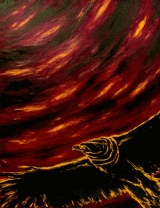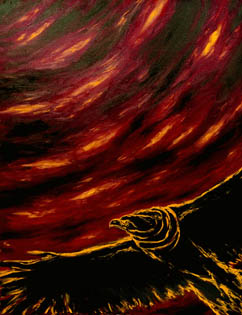
Lena Hades
Encyclopedia
Lena Hades (born October 2, 1959) is a Russia
n artist
, writer
and art theorist.
She has created more than 40 works, all oil paintings and watercolors dedicated to Nietzsche's book Also Sprach Zarathustra.
An edition of Also Sprach Zarathustra that included 20 Hades paintings from the cycle was published in 2004 in Russian
and German
by the Institute of Philosophy of the Russian Academy of Sciences
.
The works of the artist are in the State Tretyakov Gallery
, the Moscow Museum of Modern Art
, the National Center for Contemporary Arts, the State Pushkin Museum
, and others. The oil painting and graphic cycle "Also Sprach Zarathustra" was exhibited at the First Moscow Biennale
of contemporary art.
She currently lives and works in Moscow
.
She is best known not only for her Thus spake Zarathustra oil paintng and graphic cycle
but also for her two paintings so called russophobic due to the conflict between public and private spheres erupted in March 2008, when a group of Russian nationalists took an artist to court for these paintings they believe to be inciting “racial or national animosity". One, Welcome to Russia (1999), hangs in Igor Markin’s private museum Art4.ru; the other, Chimera of the Mysterious Russian Soul (1996) was exhibited only once, at a solo exhibition in the Second Moscow Biennale of Contemporary art in 2005/
The nationalists were offended by the artist’s depiction of the Russian soul as a cartoonish creature with clichéd attributes of Russian everyday life — a bottle of vodka, a model of Sputnik — and by the crudely painted text in Welcome that indicts the Russian character as simultaneously overaggressive and alarmingly God-fearing.
http://www.russia-ic.com/news/show/6321/
In Juni 2010, she was invited to give explanation for this work at a court in Moscow, it might come to a trial because she
is accused of hate propaganda (Source: http://www.civicus.org/pg/world-democracy-day/1126-to-protect-freedom-of-expression-in-russia, http://www.kasparov.ru/material.php?id=4C17C25184737)
, the antique god (Aides, Αιδης) who is the master of the dead. But the hell of Hades is not associated either with the antique or the Christian world, it is sooner connected with that of Nietzsche’s one: "even god possesses his hell – which is his love to people". "The girl with bows, the woman that mows. the dance" becomes the culmination of the series. "The dance" around pagan bonfires - the right became owned to communicate equally with the beyond. The initiation with fire that transforms and tempers the spirit is completed. There is no more fright. The terror of death has been overcome and it gives an ability to possess the sacred theme that suggested trepidation in the past. Lena Hades assimilates with stalker where the boundaries of two worlds meet each other.
ISBN 5-9540-0019-0
ISBN 88-424-9804-1

Russia
Russia or , officially known as both Russia and the Russian Federation , is a country in northern Eurasia. It is a federal semi-presidential republic, comprising 83 federal subjects...
n artist
Artist
An artist is a person engaged in one or more of any of a broad spectrum of activities related to creating art, practicing the arts and/or demonstrating an art. The common usage in both everyday speech and academic discourse is a practitioner in the visual arts only...
, writer
Writer
A writer is a person who produces literature, such as novels, short stories, plays, screenplays, poetry, or other literary art. Skilled writers are able to use language to portray ideas and images....
and art theorist.
She has created more than 40 works, all oil paintings and watercolors dedicated to Nietzsche's book Also Sprach Zarathustra.
An edition of Also Sprach Zarathustra that included 20 Hades paintings from the cycle was published in 2004 in Russian
Russian language
Russian is a Slavic language used primarily in Russia, Belarus, Uzbekistan, Kazakhstan, Tajikistan and Kyrgyzstan. It is an unofficial but widely spoken language in Ukraine, Moldova, Latvia, Turkmenistan and Estonia and, to a lesser extent, the other countries that were once constituent republics...
and German
German language
German is a West Germanic language, related to and classified alongside English and Dutch. With an estimated 90 – 98 million native speakers, German is one of the world's major languages and is the most widely-spoken first language in the European Union....
by the Institute of Philosophy of the Russian Academy of Sciences
Russian Academy of Sciences
The Russian Academy of Sciences consists of the national academy of Russia and a network of scientific research institutes from across the Russian Federation as well as auxiliary scientific and social units like libraries, publishers and hospitals....
.
The works of the artist are in the State Tretyakov Gallery
Tretyakov Gallery
The State Tretyakov Gallery is an art gallery in Moscow, Russia, the foremost depository of Russian fine art in the world.The gallery's history starts in 1856 when the Moscow merchant Pavel Mikhailovich Tretyakov acquired works by Russian artists of his day with the aim of creating a collection,...
, the Moscow Museum of Modern Art
Moscow Museum of Modern Art
The Moscow Museum of Modern Art is a museum of modern and contemporary art located in Moscow, Russia. It was opened to public in December 1999. The project of the Museum was initiated and executed by Zurab Tsereteli, president of the Russian Academy of Arts....
, the National Center for Contemporary Arts, the State Pushkin Museum
Pushkin Museum
The Pushkin Museum of Fine Arts is the largest museum of European art in Moscow, located in Volkhonka street, just opposite the Cathedral of Christ the Saviour....
, and others. The oil painting and graphic cycle "Also Sprach Zarathustra" was exhibited at the First Moscow Biennale
Moscow Biennale
The Moscow Biennale of Contemporary Art is one of the most important Russian cultural events and was founded in 2003.- First Moscow Biennale of Contemporary Art :...
of contemporary art.
She currently lives and works in Moscow
Moscow
Moscow is the capital, the most populous city, and the most populous federal subject of Russia. The city is a major political, economic, cultural, scientific, religious, financial, educational, and transportation centre of Russia and the continent...
.
She is best known not only for her Thus spake Zarathustra oil paintng and graphic cycle
but also for her two paintings so called russophobic due to the conflict between public and private spheres erupted in March 2008, when a group of Russian nationalists took an artist to court for these paintings they believe to be inciting “racial or national animosity". One, Welcome to Russia (1999), hangs in Igor Markin’s private museum Art4.ru; the other, Chimera of the Mysterious Russian Soul (1996) was exhibited only once, at a solo exhibition in the Second Moscow Biennale of Contemporary art in 2005/
The nationalists were offended by the artist’s depiction of the Russian soul as a cartoonish creature with clichéd attributes of Russian everyday life — a bottle of vodka, a model of Sputnik — and by the crudely painted text in Welcome that indicts the Russian character as simultaneously overaggressive and alarmingly God-fearing.
http://www.russia-ic.com/news/show/6321/
In Juni 2010, she was invited to give explanation for this work at a court in Moscow, it might come to a trial because she
is accused of hate propaganda (Source: http://www.civicus.org/pg/world-democracy-day/1126-to-protect-freedom-of-expression-in-russia, http://www.kasparov.ru/material.php?id=4C17C25184737)
Other works
A complete contrast to the above works is the autobiographical series "the girl with bows, the woman that mows. the dance" which are personal revelations of the artist herself. It is here that the bright image of the girl reveals a polysemantic world of the name hades, the English spelling of the name of HadesHades
Hades , Hadēs, originally , Haidēs or , Aidēs , meaning "the unseen") was the ancient Greek god of the underworld. The genitive , Haidou, was an elision to denote locality: "[the house/dominion] of Hades". Eventually, the nominative came to designate the abode of the dead.In Greek mythology, Hades...
, the antique god (Aides, Αιδης) who is the master of the dead. But the hell of Hades is not associated either with the antique or the Christian world, it is sooner connected with that of Nietzsche’s one: "even god possesses his hell – which is his love to people". "The girl with bows, the woman that mows. the dance" becomes the culmination of the series. "The dance" around pagan bonfires - the right became owned to communicate equally with the beyond. The initiation with fire that transforms and tempers the spirit is completed. There is no more fright. The terror of death has been overcome and it gives an ability to possess the sacred theme that suggested trepidation in the past. Lena Hades assimilates with stalker where the boundaries of two worlds meet each other.
Books
- Nietzsche F. “Thus spake Zarathustra”. Moscow, Institut of Philosophy of Russian Academy of SciencesRussian Academy of SciencesThe Russian Academy of Sciences consists of the national academy of Russia and a network of scientific research institutes from across the Russian Federation as well as auxiliary scientific and social units like libraries, publishers and hospitals....
, 2004.
ISBN 5-9540-0019-0
- Giametta Sossio “Commento allo Zarathustra”. Milano, Bruno Mondadori, 2006.
ISBN 88-424-9804-1
- Nietzsche F. "Morgenroethe" / translated from German by Vadim Bakusev. — Мoscow: Akademicheskij Projekt, 2007. — ISBN 978-5-8291-0942-4
- 미래를 창조하는 나 - 차라투스트라는 이렇게 말했다 (고전읽기 "I'm making the future", Seul, Mirae N Culture Group, 2009. - ISBN 978-89-378-4498-0
- Hades Lena “Chimeras by Hades: incite”. London, Alexander Kerensky Museum Publishing, 2010. - ISBN 978-1-906108-07-7
Paintings

Press about Lena Hades
- The Moscow Times, 22 June 2010, Artist Investigated in Test of Extremism Law
- Russia-InfoCentre, 22.06.2010, Artist Lena Hades Accused of Russophobia
- the Moscow News, "Art and soul on trial", 01.07.2010
- the Moscow News, "Art and soul on trial", 28.06.2010
- Yyllands-Posten, " Farlig Kunst?" 11.07.2010
- the Moscow News, "The art of revolution", 06.12.2010
- Russia Profile, "The Art of War", 02.12.2010
- Daily Mail, "Facing five years in jail, the artist who fried eggs and hotdogs on flame of World War II monument", 19.04.2011
- RadioFreeEurope, "Anarchist Art Gang Angers Russian Authorities With Provocative Antistate Antics", 06.04.2011
- Eparsa, "Kiev : Emprisonnée pour avoir cuit un œuf sur la flamme éternelle",19.04.2011
- Corriere Della Sera, "Frigge le uova sul monumento ai caduti", 19.04.2011
External links
- All Lena Hades' works
- Fotoarchive of the Russian contemporary art
- Lena Hades' works, media reviews, books, art critic articles
- Oil paintings of the cycle Thus spake Zarathustra
- Oil paintings of the cycle Chimaeras
- Lena Hades' blog in LiveJournal
- Lena Hades interview to Radio Liberty
- another Lena Hades interview to Radio Liberty
- third Lena Hades interview to Radio Liberty

